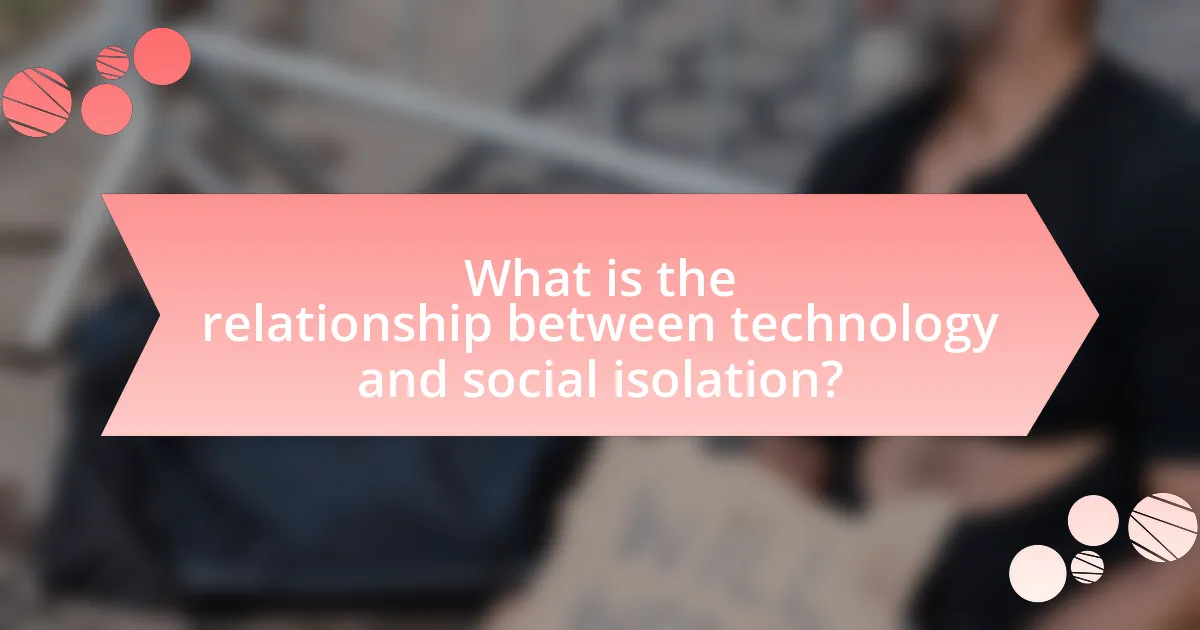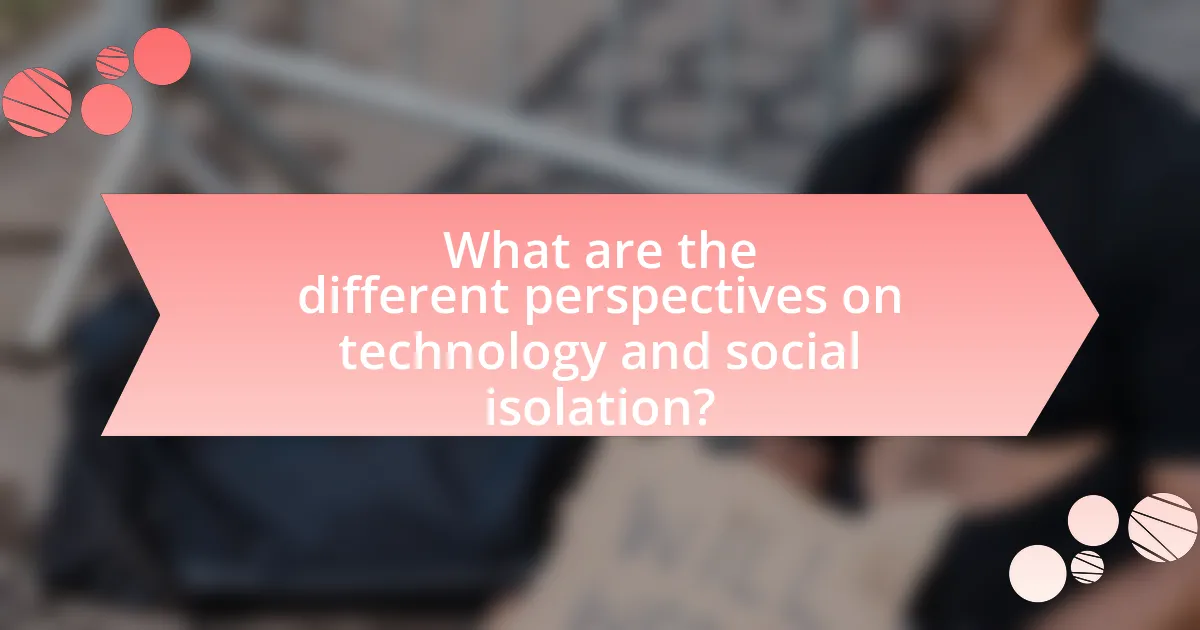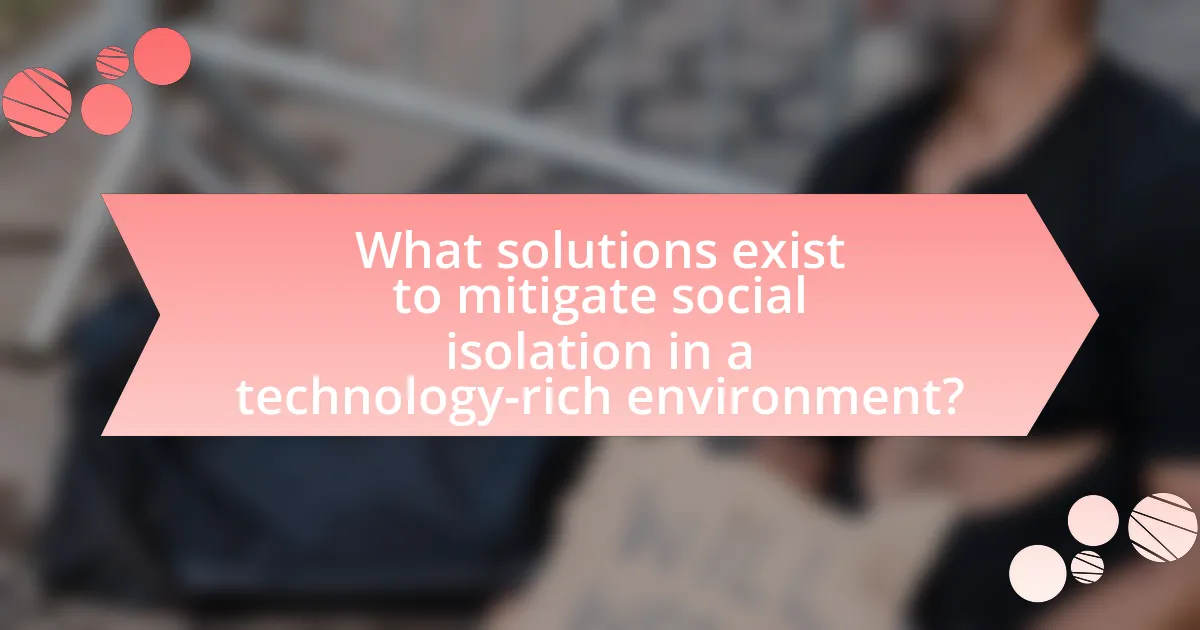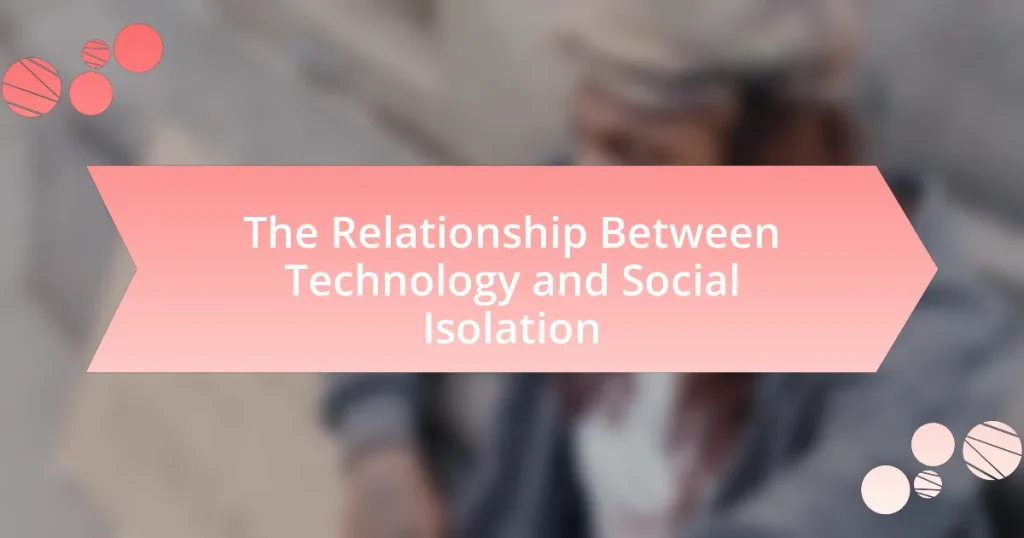The article examines the complex relationship between technology and social isolation, highlighting how technology can both contribute to and alleviate feelings of loneliness. It discusses the impact of excessive social media use on face-to-face interactions, leading to increased social isolation, while also acknowledging the role of technology in facilitating connections through online communities and support groups. Key forms of technology influencing social interactions, such as social media platforms, messaging apps, and video conferencing tools, are analyzed, along with their psychological effects on users. The article emphasizes the importance of understanding this relationship to inform public policy and personal behavior, ultimately aiming to promote healthier technology use and foster genuine social connections.

What is the relationship between technology and social isolation?
Technology can both contribute to and alleviate social isolation. On one hand, excessive use of technology, particularly social media and digital communication, can lead to reduced face-to-face interactions, fostering feelings of loneliness and isolation. A study published in the American Journal of Preventive Medicine found that individuals who spend more than two hours a day on social media are more likely to report feelings of social isolation. Conversely, technology can also provide platforms for connection, enabling individuals to maintain relationships over long distances and engage with communities that share similar interests, thus reducing feelings of isolation. For example, online support groups and virtual meetups can facilitate social interaction for those unable to participate in traditional social settings.
How has technology changed the way we interact socially?
Technology has fundamentally transformed social interaction by enabling instant communication and creating virtual communities. Social media platforms, messaging apps, and video conferencing tools allow individuals to connect regardless of geographical barriers, facilitating relationships that may not have been possible otherwise. For instance, as of 2021, over 4.2 billion people used social media globally, highlighting the significant role these platforms play in daily interactions. Additionally, studies indicate that technology can both alleviate and exacerbate feelings of isolation; while it provides avenues for connection, excessive use may lead to superficial relationships and decreased face-to-face interactions.
What are the primary forms of technology influencing social interactions?
The primary forms of technology influencing social interactions include social media platforms, messaging applications, video conferencing tools, and online gaming. Social media platforms like Facebook and Instagram facilitate communication and sharing among users, impacting how relationships are formed and maintained. Messaging applications such as WhatsApp and Telegram enable instant communication, allowing users to connect regardless of geographical barriers. Video conferencing tools like Zoom and Microsoft Teams have transformed remote interactions, especially during the COVID-19 pandemic, by providing face-to-face communication options. Online gaming platforms foster social connections through collaborative gameplay, creating communities around shared interests. These technologies collectively shape the dynamics of social interactions in contemporary society.
How do these technologies facilitate or hinder communication?
Technologies facilitate communication by providing instant connectivity and diverse platforms for interaction, while they can hinder communication by fostering superficial connections and reducing face-to-face interactions. Instant messaging, social media, and video conferencing enable users to communicate across vast distances, enhancing relationships and collaboration. However, studies indicate that reliance on digital communication can lead to feelings of isolation, as individuals may prioritize online interactions over meaningful in-person relationships, resulting in a lack of emotional depth in conversations. For instance, research published in the Journal of Social and Personal Relationships found that increased social media use correlates with higher levels of perceived loneliness among users, highlighting the dual impact of technology on communication dynamics.
What are the psychological impacts of technology on social isolation?
Technology significantly contributes to social isolation by fostering superficial connections and reducing face-to-face interactions. Research indicates that increased use of social media can lead to feelings of loneliness and depression, as individuals may substitute online interactions for meaningful relationships. A study published in the American Journal of Preventive Medicine found that individuals who spend more than two hours a day on social media are more likely to report feelings of social isolation. This suggests that while technology can connect people, it often does so in a way that lacks depth, ultimately exacerbating feelings of isolation rather than alleviating them.
How does excessive technology use contribute to feelings of loneliness?
Excessive technology use contributes to feelings of loneliness by reducing face-to-face interactions and fostering superficial connections. When individuals spend significant time on devices, they often prioritize online communication over in-person relationships, leading to a lack of meaningful social engagement. Research from the American Journal of Preventive Medicine indicates that increased screen time correlates with higher levels of perceived social isolation. This disconnect can create a cycle where individuals feel lonely despite being constantly connected online, as digital interactions often lack the emotional depth of real-life conversations.
What role does social media play in shaping perceptions of social connection?
Social media significantly influences perceptions of social connection by facilitating communication and interaction among users. It creates a virtual environment where individuals can maintain relationships, share experiences, and engage with others, often leading to a perceived sense of belonging. Research indicates that 72% of adults use social media, which enhances their ability to connect with friends and family, thereby shaping their understanding of social networks. Additionally, studies show that social media can both alleviate feelings of isolation and contribute to them, depending on usage patterns and individual experiences. For instance, a study published in the American Journal of Preventive Medicine found that high social media use is associated with increased feelings of social isolation among certain demographics, highlighting the complex role social media plays in shaping social connection perceptions.
Why is understanding this relationship important?
Understanding the relationship between technology and social isolation is important because it reveals how digital interactions can impact mental health and community engagement. Research indicates that excessive use of technology, particularly social media, can lead to feelings of loneliness and disconnection, as evidenced by a study published in the American Journal of Preventive Medicine, which found that individuals who spend more than two hours a day on social media are more likely to report feelings of social isolation. Recognizing this relationship allows for the development of strategies to mitigate negative effects, promoting healthier technology use and fostering genuine social connections.
What are the potential consequences of social isolation in a technology-driven world?
Social isolation in a technology-driven world can lead to significant mental health issues, including increased anxiety and depression. Research indicates that individuals who experience social isolation are at a higher risk for developing these conditions, as evidenced by a study published in the American Journal of Psychiatry, which found that social disconnection can lead to a 50% increased risk of premature death. Additionally, social isolation can impair cognitive function and reduce overall life satisfaction, as highlighted by findings from the National Institute on Aging, which show that loneliness negatively impacts cognitive health in older adults. Furthermore, the reliance on technology for social interaction may exacerbate feelings of loneliness, as virtual connections often lack the depth and emotional support found in face-to-face relationships.
How can awareness of this relationship inform public policy and personal behavior?
Awareness of the relationship between technology and social isolation can inform public policy and personal behavior by highlighting the need for balanced technology use and promoting social connectivity. Public policy can be shaped to encourage initiatives that foster community engagement, such as funding for public spaces and programs that facilitate face-to-face interactions, as studies indicate that increased screen time correlates with higher levels of loneliness (Twenge et al., 2019). Additionally, individuals can adjust their personal behavior by setting boundaries on technology use, prioritizing in-person relationships, and participating in community activities, which research shows can mitigate feelings of isolation and enhance overall well-being (Cacioppo & Cacioppo, 2018).

What are the different perspectives on technology and social isolation?
Different perspectives on technology and social isolation include the view that technology exacerbates feelings of isolation and the belief that it can foster social connections. Critics argue that excessive use of social media and digital communication can lead to superficial interactions, reducing face-to-face engagement and increasing loneliness. For instance, a study published in the American Journal of Preventive Medicine found that high social media usage correlates with perceived social isolation. Conversely, proponents of technology argue that it provides platforms for maintaining relationships, especially for individuals who may have difficulty engaging in traditional social settings. Research from the Pew Research Center indicates that online communities can offer support and connection, particularly for marginalized groups. These contrasting perspectives highlight the complex relationship between technology and social isolation, suggesting that the impact of technology varies based on individual usage patterns and contexts.
How do various demographics experience technology’s impact on social isolation?
Various demographics experience technology’s impact on social isolation differently, influenced by factors such as age, socioeconomic status, and geographic location. For instance, older adults often face increased social isolation despite technology use, as they may struggle with digital literacy, limiting their ability to connect online. In contrast, younger individuals typically utilize technology to enhance social interactions, using social media platforms to maintain relationships, which can mitigate feelings of isolation.
Research by Pew Research Center indicates that 40% of seniors feel lonely, highlighting a disconnect between technology access and effective social engagement. Additionally, individuals from lower socioeconomic backgrounds may have limited access to technology, exacerbating social isolation compared to their more affluent counterparts who can leverage technology for social connectivity. Thus, the impact of technology on social isolation varies significantly across different demographic groups, shaped by their unique challenges and opportunities.
What differences exist between age groups in technology use and social interaction?
Younger age groups, particularly millennials and Gen Z, tend to use technology for social interaction more frequently and in diverse ways compared to older age groups, such as baby boomers and Gen X. Research indicates that 90% of young adults use social media platforms daily, while only about 40% of older adults engage with these platforms regularly. Younger individuals often utilize technology for instant communication, sharing multimedia content, and participating in online communities, whereas older adults may prefer traditional forms of communication, such as phone calls or face-to-face interactions. Additionally, studies show that older adults are less likely to adopt new technologies, which can lead to feelings of social isolation; for instance, a study by Pew Research Center found that 46% of seniors feel overwhelmed by technology, impacting their social engagement.
How do cultural factors influence the relationship between technology and social isolation?
Cultural factors significantly influence the relationship between technology and social isolation by shaping how individuals engage with digital platforms and perceive social interactions. For instance, cultures that prioritize collectivism often encourage the use of technology for community-building and maintaining close relationships, which can mitigate feelings of isolation. Conversely, cultures that emphasize individualism may lead to increased reliance on technology for personal fulfillment, potentially exacerbating social isolation as face-to-face interactions decline. Research indicates that in collectivist societies, such as those in East Asia, technology is frequently used to strengthen familial and social ties, while in more individualistic cultures, like the United States, technology can sometimes replace in-person connections, leading to loneliness. This dynamic illustrates how cultural values dictate the role of technology in social connectivity and isolation.
What are the arguments for and against technology as a cause of social isolation?
Technology is argued to cause social isolation due to its potential to replace face-to-face interactions with virtual communication, leading to weakened social bonds. Studies indicate that excessive use of social media can result in feelings of loneliness and depression, as users may prioritize online interactions over real-life relationships. For instance, research published in the American Journal of Preventive Medicine found that individuals who spend more than two hours a day on social media are more likely to report feelings of social isolation.
Conversely, technology is also seen as a tool that can alleviate social isolation by connecting individuals across distances and facilitating communication. Video calls, social networking platforms, and online communities can provide support and foster relationships, especially for those who are geographically or physically isolated. A study from the Pew Research Center highlights that 70% of adults believe technology helps them stay connected with friends and family, suggesting that it can enhance social ties rather than diminish them.
What evidence supports the view that technology fosters social connections?
Technology fosters social connections by enabling communication across distances and facilitating interactions among individuals. Research indicates that platforms like social media and messaging apps have increased the frequency of social interactions; for instance, a study by Pew Research Center found that 72% of adults use social media, which helps them maintain relationships with friends and family. Additionally, a report from the American Psychological Association highlights that technology can reduce feelings of loneliness by providing opportunities for social engagement, particularly for those who may be physically isolated. These findings collectively support the view that technology plays a significant role in enhancing social connectivity.
What counterarguments exist regarding technology’s role in increasing isolation?
Counterarguments regarding technology’s role in increasing isolation suggest that technology can enhance social connections rather than diminish them. For instance, social media platforms enable individuals to maintain relationships across long distances, facilitating communication that would otherwise be challenging. Research by Pew Research Center indicates that 72% of teens use social media to connect with friends, which can foster a sense of belonging and community. Additionally, technology provides access to support groups and online communities for individuals who may feel isolated due to geographical or social barriers, thus promoting social interaction and emotional support. These points illustrate that technology can serve as a tool for connection, countering the notion that it inherently leads to isolation.
How can we reconcile the benefits and drawbacks of technology in social contexts?
To reconcile the benefits and drawbacks of technology in social contexts, it is essential to promote balanced usage that maximizes positive interactions while minimizing negative impacts. Research indicates that technology can enhance social connectivity, as evidenced by a Pew Research Center study showing that 72% of teens use social media to stay in touch with friends. However, excessive use can lead to social isolation, with studies revealing that heavy social media users report higher levels of loneliness. Therefore, implementing guidelines for healthy technology use, such as setting time limits and encouraging face-to-face interactions, can help individuals enjoy the advantages of technology while mitigating its adverse effects.
What strategies can individuals use to balance technology use and real-life interactions?
Individuals can balance technology use and real-life interactions by setting specific time limits for device usage and prioritizing face-to-face communication. Research indicates that excessive screen time can lead to feelings of isolation, while in-person interactions enhance social bonds and emotional well-being. For instance, a study published in the American Journal of Preventive Medicine found that individuals who engage in regular social activities report higher levels of happiness and lower levels of loneliness. By consciously scheduling tech-free times, such as during meals or family gatherings, individuals can foster deeper connections and reduce reliance on digital communication.

What solutions exist to mitigate social isolation in a technology-rich environment?
Solutions to mitigate social isolation in a technology-rich environment include fostering virtual communities, utilizing social media for connection, and implementing technology-assisted mental health support. Virtual communities, such as online forums and support groups, provide platforms for individuals to engage with others who share similar interests or experiences, thereby reducing feelings of loneliness. Social media platforms enable users to maintain relationships and connect with friends and family, which can enhance social interaction despite physical distance. Additionally, technology-assisted mental health support, such as teletherapy and mental health apps, offers accessible resources for individuals experiencing isolation, helping them to develop coping strategies and connect with professionals. Research indicates that these solutions can effectively reduce social isolation by promoting engagement and support among individuals in a technology-rich context.
How can technology be used to enhance social connections?
Technology can enhance social connections by facilitating communication and interaction among individuals through various platforms. Social media networks, messaging apps, and video conferencing tools allow people to maintain relationships regardless of geographical barriers, enabling real-time conversations and shared experiences. For instance, a study by Pew Research Center in 2021 found that 72% of adults use social media to connect with friends and family, highlighting its role in fostering social ties. Additionally, online communities and forums provide spaces for individuals with shared interests to engage and support one another, further strengthening social bonds.
What are some effective online platforms for fostering community and connection?
Effective online platforms for fostering community and connection include Facebook Groups, Discord, Reddit, and Meetup. Facebook Groups allow users to create and join communities based on shared interests, facilitating discussions and events. Discord offers real-time communication through voice, video, and text, making it ideal for gaming and hobbyist communities. Reddit hosts numerous subreddits that cater to diverse topics, enabling users to engage in discussions and share content. Meetup connects individuals with similar interests for in-person or virtual events, promoting social interaction. These platforms have been shown to enhance social connections, reduce feelings of isolation, and provide support networks, as evidenced by studies indicating that online interactions can lead to increased well-being and community engagement.
How can technology facilitate support networks for isolated individuals?
Technology can facilitate support networks for isolated individuals by providing platforms for communication and connection. Online forums, social media, and video conferencing tools enable individuals to interact with others, share experiences, and receive emotional support, regardless of geographical barriers. For instance, a study published in the Journal of Medical Internet Research found that online support groups significantly reduce feelings of loneliness and improve mental health outcomes for participants. Additionally, mobile applications designed for mental health support offer resources and community connections, further enhancing the ability of isolated individuals to engage with others and build supportive relationships.
What role do offline activities play in combating social isolation?
Offline activities play a crucial role in combating social isolation by fostering direct human interactions and building community connections. Engaging in activities such as sports, community service, or group hobbies allows individuals to form meaningful relationships, which are essential for emotional well-being. Research indicates that face-to-face interactions significantly enhance feelings of belonging and reduce loneliness, as evidenced by a study published in the Journal of Social and Personal Relationships, which found that individuals who participate in group activities report higher levels of social support and lower levels of perceived isolation. Thus, offline activities serve as a vital countermeasure to the isolating effects of technology and promote a sense of community and belonging.
How can individuals integrate offline social activities into their technology use?
Individuals can integrate offline social activities into their technology use by utilizing apps and platforms that facilitate in-person gatherings, such as event planning tools and social media groups focused on local activities. For instance, platforms like Meetup allow users to find and join local events based on shared interests, effectively bridging the gap between online connections and offline interactions. Research indicates that engaging in face-to-face social activities can significantly reduce feelings of isolation, as highlighted in a study published in the American Journal of Preventive Medicine, which found that social engagement is linked to improved mental health outcomes. By leveraging technology to organize and promote these offline activities, individuals can enhance their social networks and combat social isolation.
What community initiatives can promote face-to-face interactions?
Community initiatives that can promote face-to-face interactions include local events such as farmers’ markets, community festivals, and neighborhood block parties. These initiatives create opportunities for residents to gather, socialize, and build relationships in person. Research indicates that such gatherings can enhance social cohesion and reduce feelings of isolation, as evidenced by a study published in the Journal of Community Psychology, which found that participation in community events significantly increased social networks and support among attendees.
What practical tips can help individuals reduce social isolation while using technology?
To reduce social isolation while using technology, individuals can engage in regular video calls with friends and family, which fosters a sense of connection and presence. Research indicates that video communication can enhance feelings of social support and reduce loneliness, as it allows for visual cues and emotional expressions that text-based communication lacks. Additionally, participating in online communities or social media groups centered around shared interests can provide opportunities for interaction and support, further mitigating feelings of isolation. Studies show that active engagement in these digital spaces can lead to improved mental well-being and a sense of belonging.
How can setting boundaries around technology use improve social well-being?
Setting boundaries around technology use can significantly improve social well-being by fostering more meaningful interpersonal interactions. When individuals limit their screen time and prioritize face-to-face communication, they enhance their ability to connect emotionally and socially with others. Research indicates that excessive technology use is linked to increased feelings of loneliness and social isolation, as it often replaces direct human interaction. For instance, a study published in the American Journal of Preventive Medicine found that individuals who spend more than two hours a day on social media are more likely to report feelings of social isolation. By establishing clear limits on technology use, people can create opportunities for in-person engagements, thereby strengthening their social networks and improving overall mental health.
What are some best practices for maintaining meaningful relationships in a digital age?
To maintain meaningful relationships in a digital age, prioritize regular and intentional communication through various digital platforms. Engaging in video calls, sending thoughtful messages, and sharing experiences on social media can enhance connection. Research indicates that consistent communication fosters emotional closeness, with a study by the Pew Research Center showing that 81% of people feel more connected to friends and family through digital communication. Additionally, setting boundaries around technology use, such as designated screen-free times, can help individuals focus on in-person interactions, further strengthening relationships.
